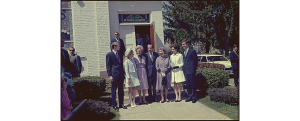Recollections of the Civil War
by James Rada, Jr.
Editor’s Note: This is the first of two articles recounting Sarah (Six) Schnure’s recollections of life in Thurmont during the Civil War. Schnure wrote her recollections while living in Hollywood, California, in the 1930s.
Sarah Six was ten years old in 1861. Her family lived in Thurmont, and Sarah grew up seeing how the Civil War affected life in town. Decades later, in the early 1930s, she wrote up her recollections of the war for her son. When the writings were discovered after her death, the Catoctin Enterprise published the writings.
Her first memory associated with the Civil War was when the entire town turned out at the downtown square to see the Thurmont men march off to Frederick to be sworn in as soldiers. She wrote, “Never shall I forget that morning that crowd of women trying to be brave and send off their men with smiles when their hearts were breaking.”
The men seemed excited, as if they were venturing off for a grand adventure. For many of them, it would be an adventure, since in the days before the Western Maryland Railroad reached Mechanicstown, they hadn’t ever ventured far from town in their lives.
In the years to come, the wives and mothers of Mechanicstown would live in a state of anxiety, wondering what had become of the husbands and children. News about the war did not arrive often. There was no daily newspaper and mail came only three times a week. The telegraph had not been installed in town, and the telephone did not exist.
“News traveled slowly and when there was a battle on, many days would elapse before any report of it reached our town,” Sarah wrote.
In support of their Union soldiers, the women of Mechanicstown would often gather at St. John’s Lutheran Church to bag up old linen that would be sent off to Union hospitals to be turned into bandages. Sarah and other children would do their part by gathering wild cotton that was also sent to the hospitals.
One night around midnight in 1862, the Six family was awakened by a barking dog. Then they heard Henry Foreman, the neighbor’s son, calling, “Get up, Mr. Six! The rebels are coming.”
The family got dressed and turned out into the street, along with the rest of the town. In the dark of night, they watched army ambulances come through the town with wounded that they were transporting to safety in Pennsylvania. They also came with news that the rebels had crossed the Potomac River.
Most likely, this would have been early in the morning of September 5. After General Robert E. Lee’s victory at the Second Battle of Bull Run at the end of August, Lee moved his army into Maryland, with the intention of securing a victory in the North. He wanted to keep his army on the offensive and influence the fall elections in the North so that congressmen and senators willing to recognize the Confederate States of America might be elected. In addition, Lee needed supplies for his army that the South was running out of.
As the army had approached Frederick, citizens, military, and patients from the United States Military Hospital fled the city.
As the ambulances moved through town, drivers and patients requested food and coffee. It was provided as much as the citizens could manage, but Sarah noted that because Mechanicstown had no bakeries, many homes went without bread for breakfast that day.
Some of the residents in town packed up and headed north with the army. Others hunkered down and hid valuables, livestock, and food.
“Mother had valuables packed and ready to flee into the mountain. I had few treasures but two of them were in my pocket—a small silk union flag and my treasured china doll,” Sarah wrote.
The Confederate army did not continue north from Frederick. They turned west and would go on to fight the Battle of South Mountain and the Battle of Antietam before retreating south back across the Potomac.

 Easter at Camp David
Easter at Camp David